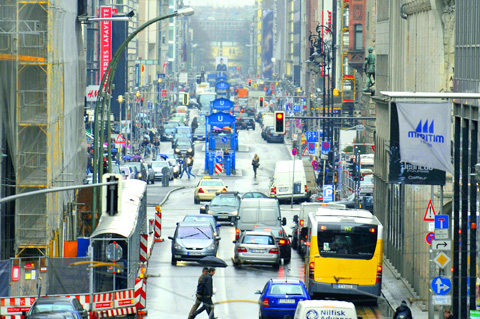It can be hard to find what remains of the Berlin Wall, a divisive landmark that for 28 years split the German capital and an entire generation.
But history buffs wanting to see the last vestiges of the iconic symbol of East versus West no longer have to consult old maps or seek out guidebooks. A new multimedia guide offers individualized walking tours connecting key points where the 166km-long wall once stood.
The hand-sized minicomputer, commissioned by the city government and to be introduced on Thursday, is linked to global positioning satellites (GPS) mapping the wall’s former path.

PHOTO: AFP
Boasting a headset and a touch-screen, it features a colorful city map that can zoom in and out, showing users where they are. The route of the former barrier between East and West Germany is marked in red while a yellow line guides the visitor from one wall section to the next, calculating the distances via GPS in meters.
“With the help of this guide, we finally have an answer to the most often asked question: ‘Where was the wall?’” Berlin Mayor Klaus Wowereit told reporters as he introduced the new gadget last week.
Most of the wall was torn down after communist East Germany collapsed and the border was opened in 1989.
A city project to mark the wall’s path is scheduled for completion by 2011, the 50th anniversary of the wall’s construction.
Apart from guiding tourists from one wall memorial to the next — among them the Brandenburg Gate, Checkpoint Charlie and the mural-covered East Side Gallery — the digital assistant gives information about 22 historically significant spots along the wall’s route.
Starting on Thursday, the wall guides can be rented at five booths throughout the city. They cost between US$9.50 and US$24 depending on how long visitors want to keep them.

SELL-OFF: Investors expect tariff-driven volatility as the local boarse reopens today, while analysts say government support and solid fundamentals would steady sentiment Local investors are bracing for a sharp market downturn today as the nation’s financial markets resume trading following a two-day closure for national holidays before the weekend, with sentiment rattled by US President Donald Trump’s sweeping tariff announcement. Trump’s unveiling of new “reciprocal tariffs” on Wednesday triggered a sell-off in global markets, with the FTSE Taiwan Index Futures — a benchmark for Taiwanese equities traded in Singapore — tumbling 9.2 percent over the past two sessions. Meanwhile, the American depositary receipts (ADRs) of Taiwan Semiconductor Manufacturing Co (TSMC, 台積電), the most heavily weighted stock on the TAIEX, plunged 13.8 percent in

A wave of stop-loss selling and panic selling hit Taiwan's stock market at its opening today, with the weighted index plunging 2,086 points — a drop of more than 9.7 percent — marking the largest intraday point and percentage loss on record. The index bottomed out at 19,212.02, while futures were locked limit-down, with more than 1,000 stocks hitting their daily drop limit. Three heavyweight stocks — Taiwan Semiconductor Manufacturing Co (TSMC, 台積電), Hon Hai Precision Industry Co (Foxconn, 鴻海精密) and MediaTek (聯發科) — hit their limit-down prices as soon as the market opened, falling to NT$848 (US$25.54), NT$138.5 and NT$1,295 respectively. TSMC's

ASML Holding NV, the sole producer of the most advanced machines used in semiconductor manufacturing, said geopolitical tensions are harming innovation a day after US President Donald Trump levied massive tariffs that promise to disrupt trade flows across the entire world. “Our industry has been built basically on the ability of people to work together, to innovate together,” ASML chief executive officer Christophe Fouquet said in a recorded message at a Thursday industry event in the Netherlands. Export controls and increasing geopolitical tensions challenge that collaboration, he said, without specifically addressing the new US tariffs. Tech executives in the EU, which is

TARIFFS: The global ‘panic atmosphere remains strong,’ and foreign investors have continued to sell their holdings since the start of the year, the Ministry of Finance said The government yesterday authorized the activation of its NT$500 billion (US$15.15 billion) National Stabilization Fund (NSF) to prop up the local stock market after two days of sharp falls in reaction to US President Donald Trump’s new import tariffs. The Ministry of Finance said in a statement after the market close that the steering committee of the fund had been given the go-ahead to intervene in the market to bolster Taiwanese shares in a time of crisis. The fund has been authorized to use its assets “to carry out market stabilization tasks as appropriate to maintain the stability of Taiwan’s